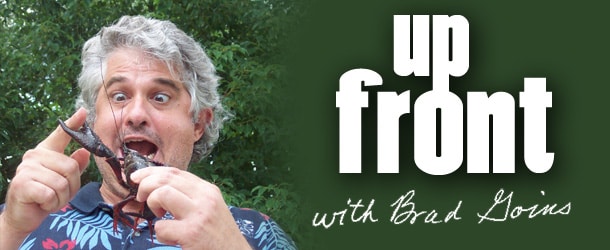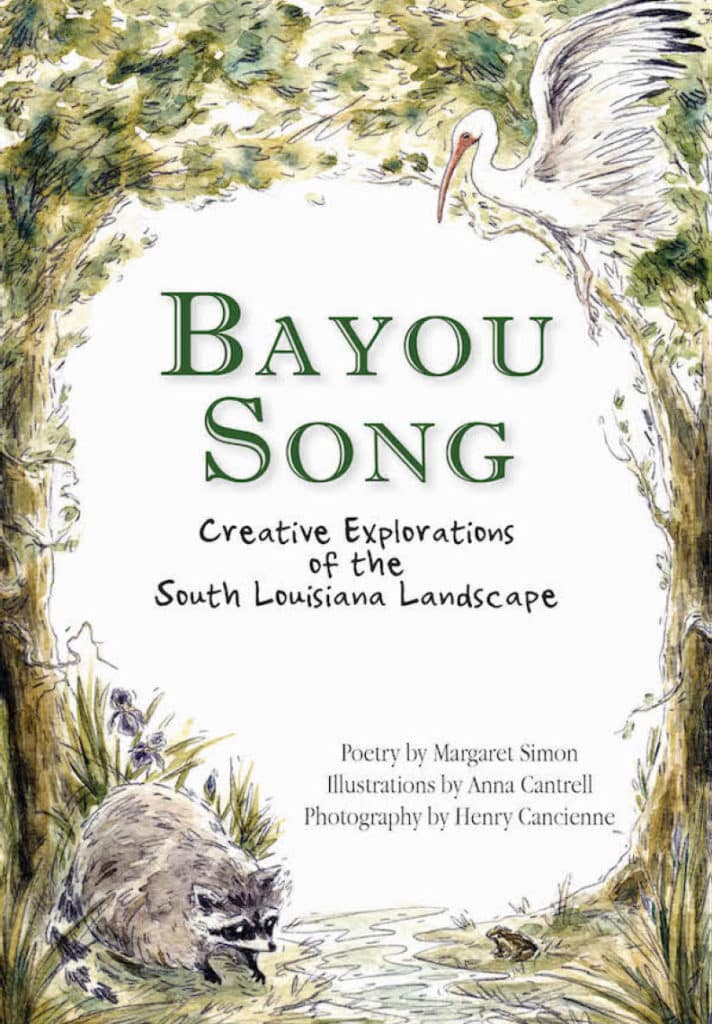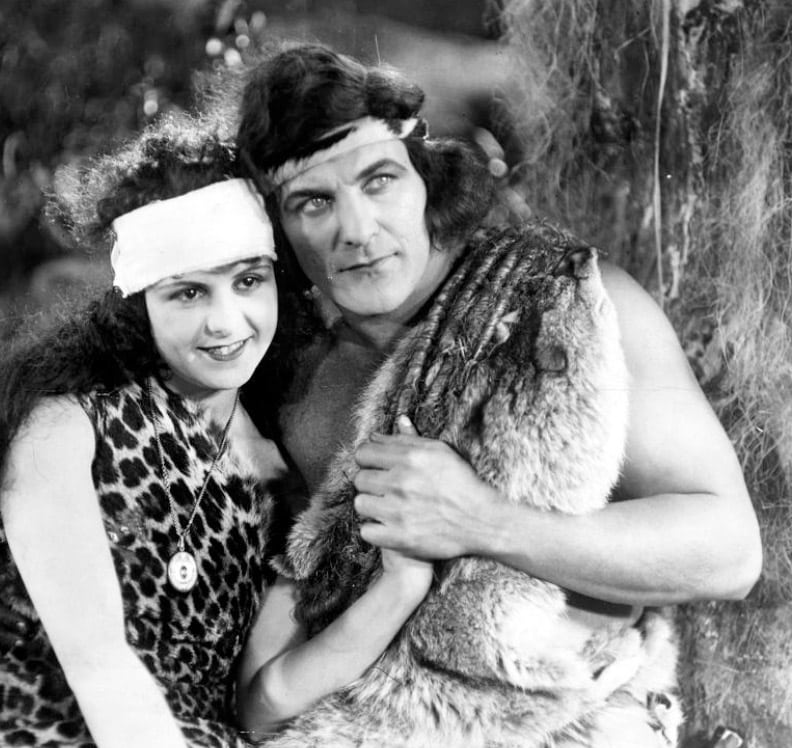From the University of Louisiana at Lafayette Press comes a new book — Bayou Song: Creative Explorations of the South Louisiana Landscape. This spiral-bound book is primarily designed for youths and their teachers. However, I think many adults would enjoy its art and information, and the opportunities for creative activity that it provides.
The book takes a look at numerous aspects of nature on the Louisiana coast. It then guides readers through the processes of writing about and drawing these natural marvels.
Each section of the book begins with photos of, and a short essay about, some South Louisiana phenomenon, such as Spanish moss, cypress knees or the white ibis. Turn the page, and there’s an illustration of the phenomenon; on the facing page is a short poem about it.
Turn one more page and you’ll get a list of blank lines. This is for writing a poem about the matter at hand. At the bottom of the page are short guidelines that help readers try to recreate the sort of poem they’ve just read (for example, a tercet that uses a metaphor, a poem that uses repetition or a series of rhyming couplets). Instructions for writing the six-line Welsh poem called a “clogyrnach” are quite specific. Margaret Simon (who writes the poems in the book) notes that “forms can be challenging, but can also give you a creative way to write a message.” (This sort of thing is a good curative for the popular notion that any random thoughts a person scribbles on a page constitute a “poem.”)
On the right hand page, the reader creates a drawing about what he has read about in the essay. Each right-hand page is covered with rows of barely visible dots spaced a quarter-inch apart. The dots, I’m guessing, are there as an aid that will increase the ease with which young readers give shape to their drawings. Again, tips for drawing are found at the bottom of the page. Here are some representative guidelines: “Draw an owl’s face. Follow the line from the nose around the two eyes … Make the owl’s pupil large with another larger circle around it.” The reader can easily flip back a page to check the illustration of the owl.
The essays are short but packed with information. One learns that a cypress tree can live as long as 600 years. A resurrection fern can lose 97 percent of its moisture and appear grayish brown, yet still be alive. The snapping turtle lures in prey by sticking out his tongue, the end of which looks like a worm.
Poet Margaret Simon has been an elementary school teacher for 31 years, most recently in New Iberia. She calls living on the Bayou Teche “a daily adventure.” Her blog can be found at reflectionsontheteche.com. Illustrator Anna Amelia Cantrell is fond of whimsical watercolors of subjects in nature (as one can easily see in the book; the first illustration in the volume shows a racoon fiddling while two blue herons do a formal dance). Henry Cancienne is the photographer.
The 120-page book retails for $19.95. For more information, call 482-6350 or visit ulpress.org.
Dum-Dum Convention
In the past, the Up Fronter has informed readers about Louisiana festivals where people compete to do the best job of yelling like Marlon Brando in A Streetcar Named Desire. Now comes word of a conference where you can compete to yell like Tarzan.
The Edgar Rice Burroughs Dum-Dum Conference 2018 will take place from Aug. 2-5 in Morgan City. The purpose of this four-day event is to celebrate the 100th anniversary of the release of the 1918 silent film Tarzan of the Apes, which starred a bunch of people none of us ever heard of. The movie was the first one that was based on Edgar Rice Burroughs’ novel Tarzan of the Apes. The people who made it decided the woods around Morgan City were the closest thing to Tarzan’s jungle they could find in the U.S.
The yelling part of the conference is called the “King & Queen of the Jungle costume and yell contest.”
Why, you may be wondering, does the strange phrase “Dum-Dum” appear in the title of this conference? Well, to make a short story long, in the Burroughs novels, Tarzan was raised by animals called the Mangani apes. These apes were Burroughs’ idea of the “missing link” — a widespread notion in his time. The Mangani spoke a rudimentary language, and had organized a basic government and elaborate rituals. These traits accounted for the fact that Tarzan was able to learn western languages and social customs.
I haven’t forgotten about the “Dum-Dum.” That was a “collective celebration” the Mangani held when they’d killed a major enemy. When the moon rose, the Mangani gathered around the body of the vanquished opponent. While the female apes beat the drums, the male apes danced around the body. So that’s your basic Dum-Dum, with a few details omitted for the sake of brevity.
Speaking at the event will be Al Bohl, an instructor in animation for the Bossier Parish School system and the director of the documentary Tarzan: Lord of the Louisiana Jungle. Bohl has also re-edited the 1918 Tarzan movie. He’s written a book titled Zaanan: The Mermen of Immersia, which to these ears sounds a tad like Tarzan of the Apes. Three other experts on Tarzan will speak.
On Aug. 3 at 3 pm, there will be an auction. On the evenings of both Aug. 2 and 3, there will be a dine around. I don’t know what a dine around is, but I can tell you that whatever it is, it will be all systems go. On the morning of Aug. 4, attendees can take tours of the site where the film was shot and another nearby swamp. After the yelling contest, there will be a banquet at Cafe Jo Jo’s.
The cost for this little clam bake is $105. You can register with Morgan City’s Cajun Coast Visitors and Convention Bureau at (985) 380-8224. If you want to stay at the Clarion Hotel and Convention Center, make your reservations at (985) 385-2200. Tell them you’re with the Dum-Dum Convention. If you want a yelling contest t-shirt, that’ll set you back an extra $20, and the swamp tour (if you want to take it) will cost you another $35.
The Horror Of The Wednesday Holiday
Workers in some parts of the country were frustrated when July 4 fell exactly in the middle of the week. There it sat — right smack dab on a Wednesday. Plop.
You sell the Lake Charles worker very short if you assume he can’t get a long weekend out of a holiday just because it comes in the middle of a week. In this instance, it was just a matter of whether to take off the two days before July 4 or the two days after. This time around, the two days after won out. That gave the L.C. worker a July 4 that lasted 120 hours, ending at roughly 8 am on Monday, July 9.
Of course, the L.C. worker could have taken off the two days before and the two days after. It’s not that the L.C. worker isn’t capable of taking a solid week off work for a single-day, mid-week holiday. It’s just that the notion hasn’t occurred to him yet. Give it a decade or two.
The big story this July 4, though, wasn’t about employment; it was about the weather. The City of Lake Charles moved the outdoor July 4 festivities because of rain.
Wasn’t it a bit drastic to move the July 4 events because it was raining? Well, perhaps; but that’s not quite how it happened. The city moved the events not because it was raining, but because 24 hours before the events, meteorologists were forecasting rain for the time when the events were set to take place. See, you knew there had to be a reasonable explanation, and there was. The day to day way of things is just as orderly as everyone says it is. You can trust me.
Now we come to July 4. On the day itself, forecasters are predicting a 100-percent chance of rain all day. Behold the glorious sunshine. See how its bold, bright rays illuminate the clear skies and bathe everything in sight in a warm, inspiring glow.
When government and meteorology agree that rain is certain, lovers of the sun perk up and set the alarm for some time well before sunrise.
In Queso You Missed It
This is a brand new section of Up Front that’s devoted to the kind of news you only read twice. Our featured news source for this new section is Baton Rouge’s Bite & Booze, which just reported for the second time in a month the great, fantastic, really important, super big, amazingly wonderful, splendiferous news that Gov’t Taco has opened in Baton Rouge. Let’s read this breaking news story exactly as it appeared in the original, with not a single exclamation point, punctuation error or pun changed:
“ICYMI…
“In queso you missed it, White Star Market is finally open on Government Street which means
“!!! GOV”T TACO IS FINALLY OPEN !!!
“Popping off with a stellar line up of flagship tacos, sides and aqua frescas you can swing by the market and grab some tacos, have a drink and enjoy the neighborhood!”
Popping off? When a person reads that kind of thing — and for the second time, no less — he might get the idea that he’s reading more about promotion than reportage. Whatever it is, that piece of writing hardly answers the questions of inquiring minds; questions such as: What the hell is GOV”T — excuse me, GOV’T — TACO? What’s so special about it? Why haven’t I heard of it? What makes its tacos different from any other tacos? Why does it have such a strange name? What does government have to do with tacos? Isn’t it the case that when we eat tacos, we’re trying to have fun, which means the last thing we want to do is think about government? Am I right or am I right?
Jayne’s Last Days
The June 28 issue of Louisiana Cultural Vistas contains an article by entertainment writer John Wirt on the famous car crash that killed Jayne Mansfield as she was being driven to New Orleans on US 90 in 1967. Mansfield and everyone else in the front seat died instantly; Mansfield’s three children in the back seat survived.
The persistent urban myth that Mansfield was decapitated was caused by the appearance of one of her blonde wigs on the hood of the wreck. A journalist saw the hood and drew his own conclusions. In the story, Wirt says that the Orleans Parish coroner of the time, Nicholas Chetta, stated that Mansfield died of blunt force trauma, as did everyone else in the front seat.
Wirt provides a good overview of Mansfield’s career and quotes several highly complimentary remarks about her kind personality. Go to knowlouisiana.org and search for “Lost Highway: Jayne Mansfield’s Last Days in Louisiana.” The same issue includes articles on zydeco music legend Ida Guillory (“Queen Ida”) and prominent Civil War Gen. P.G.T. Beauregard.

















Comments are closed.